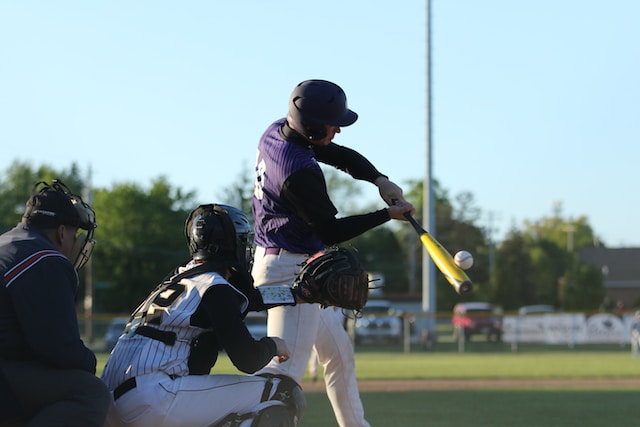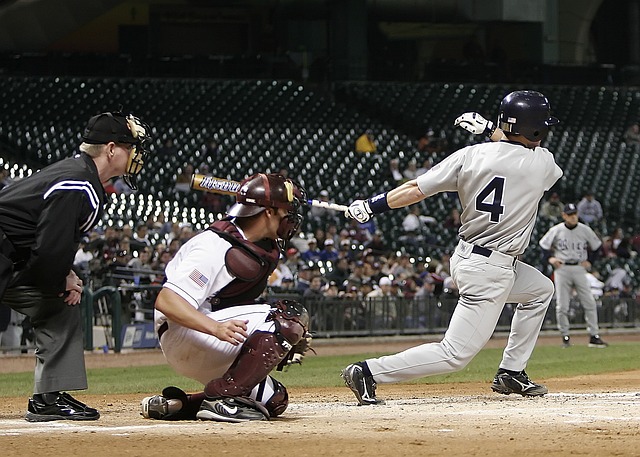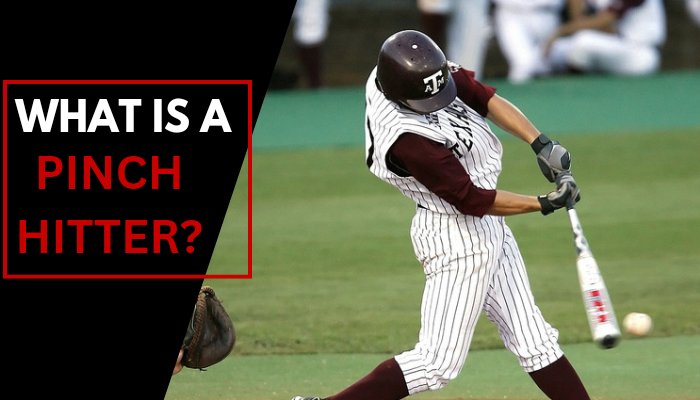Pinch hitters can be useful to change the momentum of any baseball game. They can enter the game at any time and help the team score runs. But do you know what is a pinch hitter?
A pinch hitter is a substitute player who comes to bat in place of another batter in a baseball game. A team coach or manager may use a pinch hitter to replace a weak or injured hitter in the batting lineup.
But who, when, where, and how does a team use pinch hitters? Keep scrolling as I answer all your questions in detail about using a pinch hitter.
What is a Pinch Hitter in Baseball?
Every team in a baseball game usually has nine hitters in their batting lineup. They are arranged in a specific order and come to bat one after one.
But not all of them perform well in a game. There can be some weak hitters. Plus, a hitter may also get injured during the match.
In such critical situations, teams can use pinch hitters to ensure an optimum performance.
A pinch hitter in baseball is a substitute replacing another hitter or batter in the game. Using a pinch hitter can be a strategy for the team to win the game. It can also be due to the injury of a batter.
Who Do You Use as a Pinch-Hitter?
Who you use as a pinch hitter depends on various factors. For instance, the game situation, the skills of the available pinch hitters, and the plan to gain a strategic advantage are some of the factors to consider.

In close game scenarios, the manager may use a pinch hitter with excellent hitting ability so that he can help the team win.
Then again, if you are deploying the pinch hitter early in the game, you may want to use someone who can perform well in the defensive position later in the game.
In many leagues, there is no designated hitter rules, and the pitcher also needs to bat. But the pitchers are usually weak hitters. In that case, you may use a specialist pinch hitter in place of the pitcher to ensure runs keep coming.
When Do You Use a Pinch Hitter?
You can use a pinch hitter at any time of the baseball game when the ball is dead or not active. In most cases, teams use pinch hitters in the late innings to shift the momentum of the game.

But if one of your hitters gets injured during the game, you may need to use the pinch hitter early in the game. In that case, you won’t have the freedom to pick when or whom you replace.
Besides, if you feel the active batters are underperforming, then you may also use a pinch hitter for quick runs.
However, you must keep in mind that once you replace a player with a pinch hitter, he can not get back into the game. Hence, you need to be careful about whom you are replacing and when you are doing it.
Pinch Hitter vs. Designated Hitter
While both a pinch hitter and a designated hitter (DH) are involved in batting for another player, they serve very different roles in baseball.
A pinch hitter is a substitute who comes into the game to bat for another player, often in crucial moments. Once they hit, the original player they replaced cannot return to the game. This makes pinch hitting a one-time, strategic move where the manager is willing to sacrifice a player in the lineup to get a better hitter at the plate.
A designated hitter, on the other hand, is a permanent spot in the lineup, typically used in the American League. The DH hits in place of the pitcher throughout the entire game but doesn’t play a defensive position.
This is different from the National League, where pitchers must hit for themselves, unless a pinch hitter is used. While the DH role is more predictable and fixed, the pinch hitter role is all about flexibility and adapting to the game’s unfolding dynamics.
What is the Role of a Pinch Hitter?
The primary role of a pinch hitter is to bat and score for the team. However, due to different game conditions, the pinch hitter’s role may vary.
Here are some of the common roles of a pinch hitter in a baseball game:
- Score runs: When active hitters are failing to score, the manager may use a pinch hitter. In such situations, the pinch hitter’s role will be to make some quick runs to move the scoreboard.
- Playing in defensive positions: If a batter is injured and the pinch hitter is playing in place of him, then he may need to bat as well as play in defense. He should be skilled at both defense and offense.
- Help in gaining competitive advantage: Managers may also deploy pinch hitters to exploit the opposition’s weakness and gain competitive advantage. For instance, if the pitcher is left-handed, a right-handed pinch hitter can be used who may have a good history of hitting against left-handers.
- Be a match winner: Lastly, the pinch hitter should be able to adapt to different pressure situations. He should play a significant role in winning the game. Although a team effort is required to win, a pinch hitter can provide the spark the team needs.
In short, the role of a pinch hitter in a baseball game is to follow the game strategy and ensure the team wins. He may not always become successful, but the pinch hitter should improve overall team performance.
Impact of a Pinch Hitter on the Game
A pinch hitter can completely shift the momentum of a baseball game. When a team is trailing or locked in a close game, bringing in a fresh batter can put pressure on the opposing team.
The opposing team knows that the pinch hitter is typically a strong hitter, often chosen for their batting expertise in high-stakes situations. This puts the spotlight on the matchup between the new batter and the pitcher.
One of the most significant impacts a pinch hitter can have is changing the flow of the game. A well-timed hit can turn a losing game into a comeback or give a team the lead in extra innings.
Pinch hitters are often used in high-leverage situations, like with runners in scoring position or when a game-tying or winning run is at stake. In these moments, a pinch hitter’s success or failure can be the difference between victory and defeat.
However, pinch hitting also comes with risks. Since the player is often cold, coming straight off the bench without having taken any previous at-bats in the game, they must quickly adapt to the pitcher’s style and speed.
That’s why not every player thrives in this role—pinch hitters are often chosen for their mental toughness and ability to perform under pressure.
In many cases, a pinch hitter can also lead to a series of strategic counter-moves from the opposing team, such as a pitching change, making the situation even more dynamic.
Where to Use a Pinch Hitter?
You can use a pinch hitter in any position in the batting lineup. But most teams like to use it in the weakest spot in the batting order. It allows them to move up the scoreboard fast.
Unless a specific hitter is injured, the manager is free to pick the spot for a pinch hitter. Not to mention, the manager must be strategic to gain the maximum benefits from the pinch hitter.
How Many Pinch Hitters Can You Use in a Game?
You can use as many pinch hitters as you want to use, depending on the roster size. There is no specific limit or restrictions on how many pinch hitters you can use in a baseball game.
But as you can not use the player you substituted with a pinch hitter, you must be strategic about using pinch hitters.
In some leagues, the pitcher is also required to bat. It will not be wise to use pinch hitters in place of him early in the game just because it does not have any limit. Using pinch hitters recklessly can negatively affect a team.
Rules Regarding Pinch Hitters in Major League Baseball
The use of a pinch hitter in Major League Baseball (MLB) is governed by a few key rules:
- One-Time Substitution: When a pinch hitter is brought into the game, the player they replace is permanently removed from the lineup. That means the original player cannot re-enter the game at any point. The pinch hitter can remain in the game and take on the defensive role of the player they replaced, but this often depends on the player’s defensive abilities.
- Timing: A pinch hitter can be substituted at any point during a game, but most substitutions happen in late innings when the game is tight and the team needs a key hit. Managers will often save their best pinch hitters for these critical moments.
- Player Eligibility: Any player on the roster can be used as a pinch hitter, but it’s common to have a few players designated as “bench players” who excel in pinch-hitting situations. Teams with deep rosters often have more flexibility in this regard.
These rules make pinch hitting a strategic tool for managers, who must weigh the potential gains against the consequences of removing a player from the game.
How Do You Use a Pinch-Hitter?
You need to be tactical while using a pinch hitter in a baseball game. First, you need to assess the game situation. Based on it, you need to determine which pinch hitter you are going to use.
The manager or the coach needs to inform the home plate umpire about the pinch hitter. Then, the pinch hitter’s name, number, and the player who will be substituted is announced.
Finally, the pinch hitter takes his place in the batter’s box and the game resumes. This is the standard rule to use pinch hitters in leagues like MLB. It can slightly vary depending on which league you are playing.
Best Pinch Hitters in MLB History
There have been many pinch hitters used in the MLB games. However, not all of them provided the desired performance.
Here are the top 10 best pinch hitters in MLB history based on hit count:
Here’s the updated list of top MLB pinch hitters with the latest information:
| Position | Name | Pinch Hits |
|---|---|---|
| 1 | Lenny Harris | 212 |
| 2 | Mark Sweeney | 175 |
| 3 | Manny Mota | 150 |
| 4 | Smokey Burgess | 145 |
| 5 | Matt Stairs | 122 |
| 6 | Dave Hansen | 138 |
| 7 | Greg Gross | 143 |
| 8 | Jerry Lynch | 116 |
| 9 | Rusty Staub | 100 |
| 10 | Willie McCovey | 98 |
Lenny Harris remains the all-time leader with 212 pinch hits, followed by Mark Sweeney and Manny Mota, solidifying their places as baseball legends in this unique role.
Challenges of Being a Pinch Hitter
Being a pinch hitter may sound glamorous, but it’s one of the most challenging roles in baseball. Imagine sitting on the bench for several innings, watching the game unfold, and then being asked to step in and immediately deliver a hit against a top-tier pitcher. That’s exactly what pinch hitters face every time they are called upon.
One of the biggest challenges is the lack of rhythm. Most players build their confidence and timing throughout a game by getting multiple at-bats, but a pinch hitter doesn’t have that luxury.
They come into the game cold, often facing a pitcher who has already settled into a groove. It’s a mental and physical test, requiring the player to be prepared to hit with very little notice.
Another difficulty is the pressure. A pinch hitter is almost always used in high-leverage situations, which means the stakes are high, and the team is counting on them to produce.
The mental toughness required to perform under these conditions is immense. Some players struggle with the pressure, while others, like the great pinch hitters, seem to thrive in these moments.
Furthermore, opposing managers often respond to pinch hitters by making pitching changes. For example, if a left-handed batter is brought in as a pinch hitter, the opposing team might bring in a left-handed pitcher to neutralize the matchup.
This adds another layer of complexity to the pinch-hitting role, as the player must quickly adapt to facing a new pitcher they may not have prepared for.
Pinch Hitting in Modern Baseball
In modern baseball, the use of pinch hitters has evolved, with analytics playing a larger role in decision-making. Teams now rely heavily on data and statistics to determine the best matchups, meaning a pinch hitter is often chosen based on how they perform against a specific type of pitcher, such as a left-hander or right-hander, or how well they fare in certain ballparks.
For example, some hitters may excel against fastball pitchers, while others are better suited to handle breaking balls. Managers use this data to optimize their chances, strategically selecting pinch hitters based on a variety of factors like recent performance, pitcher tendencies, and even weather conditions.
In the past, pinch hitters were often veterans or players near the end of their careers who were known for their hitting ability. Today, teams often carry versatile players who can perform as both fielders and pinch hitters, increasing their value on the roster. In addition, roster flexibility has become more important, with managers using their benches in more creative ways to gain an advantage.
The introduction of the universal designated hitter in 2022 across both the American and National Leagues has slightly reduced the need for pinch hitters, especially for pitchers. However, the role remains crucial in late-game situations and for teams that need to spark a rally or get that crucial hit when the game is on the line.
FAQs:
Can a pinch hitter play in defense after batting?
Yes. Once a pinch hitter is used in a game, he can bat as well as take a defensive position. He will play the remaining games without any restrictions.
Can the replaced player return in place of the pinch hitter?
No. Once a player is substituted with a pinch hitter, he can not re-enter the game by any means. If the pinch hitter needs replacement, a different player will have to be the substitute.
Why is it called a pinch hitter?
The term “pinch hitter” is believed to come from the nineteenth century. It is called pinch hitter because the hitter usually comes “in a pinch” or in a critical moment in the game.
What are the qualifications to become a pinch hitter in baseball?
There are no special qualifications required to be a pinch hitter. Anyone who is on the roster can be used as a pinch hitter. However, the coach may choose the pinch hitter based on their hitting and fielding abilities.
My Opinion on the Use of a Pinch Hitter
A pinch hitter can be a great asset to every team. If the coach or the manager know how to use the hitter strategically, it can help the team win games.
As a coach, I have used pinch hitters many times, and it helped my team a lot. It always did not work, but most of the time, my strategy with the pinch hitter helped me win games.
Not to mention, the pinch hitter rules can make the game more exciting for the viewers, too. When any game feels one-sided, a team may come back into the game by using pinch hitters.
More Resources
What Is Chin Music In Baseball
What Is A Perfect Game In Baseball
What Is A Good Batting Average
What Is A No Hitter In Baseball

Hello everyone. My name is Jason Butler, and I live in California, America. I was a professional AAA Minor League Baseball player. I lost my chance of playing MLB for injury issues, but I did not lose my love for baseball. I attended the coaching training program and am now working as a coach in a small school in San Diego.
I always love to share my experience and knowledge if that can help you. Play baseball, and stay fit.
